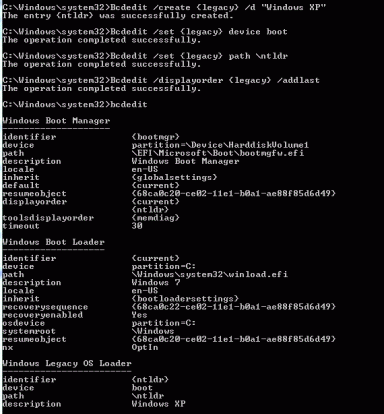- Thread Author
- #1
Hi,
I was trying to make a dual boot system and came across this problem. Hope someone could help.
I have two HDDs, one with Win XP in it and other in which I am trying to load Win 7. I made a primary partition (NTFS) through Win XP in the second HDD (labelled it I) and started loading Win 7 through a bootable pendrive. Things went fine till the installation was complete. Then, when I restarted the system, there was no Boot manager screen, Win 7 just started booting the system ! When I looked into the file system, the partition in which Win7 was installed (I: ) was labelled to C (whereas C was the name of the partition in which Win XP is installed !).
I have two queries:
1. Is it possible to install Win 7 in drive labelled I only (I understand that physically it is the same drive in which I had intended to install it). That's because a small sys. reserved folder is getting created which (most probably) is storing the swap data.
2. How to get the boot manager screen option ie. get the selection screen in the beginning to select b/w XP and 7.
Thanks,
Emma Good
I was trying to make a dual boot system and came across this problem. Hope someone could help.
I have two HDDs, one with Win XP in it and other in which I am trying to load Win 7. I made a primary partition (NTFS) through Win XP in the second HDD (labelled it I) and started loading Win 7 through a bootable pendrive. Things went fine till the installation was complete. Then, when I restarted the system, there was no Boot manager screen, Win 7 just started booting the system ! When I looked into the file system, the partition in which Win7 was installed (I: ) was labelled to C (whereas C was the name of the partition in which Win XP is installed !).
I have two queries:
1. Is it possible to install Win 7 in drive labelled I only (I understand that physically it is the same drive in which I had intended to install it). That's because a small sys. reserved folder is getting created which (most probably) is storing the swap data.
2. How to get the boot manager screen option ie. get the selection screen in the beginning to select b/w XP and 7.
Thanks,
Emma Good
